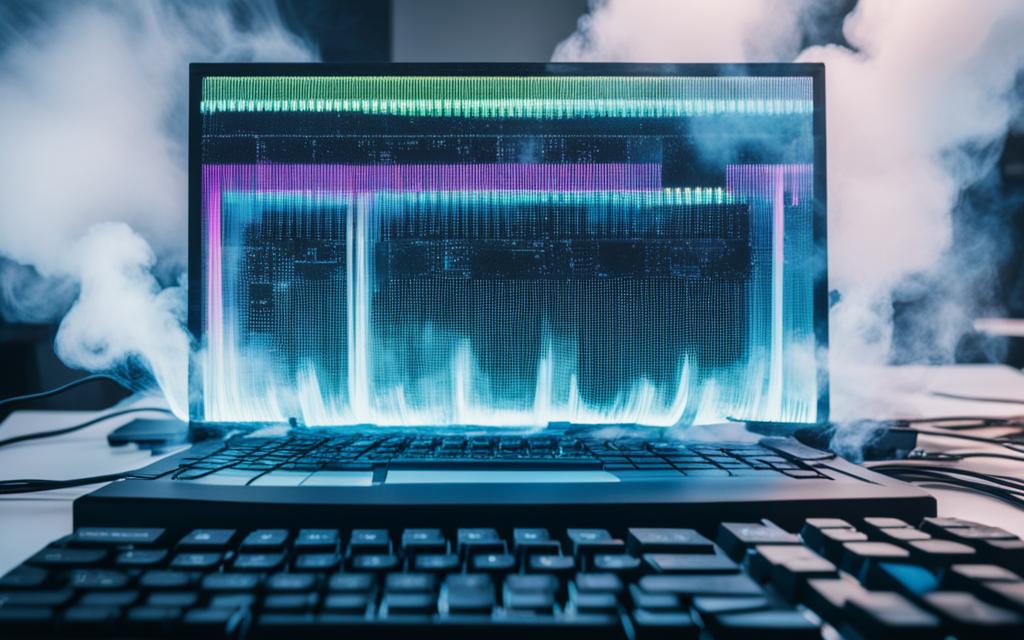Table of Contents
The CPU is the computer’s brain, handling many tasks and managing system work. CPU failure symptoms should be noticed early to avoid big troubles. Signs like crashes, too much heat, and boot problems can mean your CPU might fail soon. This article talks about these symptoms and how to diagnose CPU issues. We also cover how to stop them for better performance. For more info on CPU problems, check this link on understanding CPU processor failure symptoms1.
Key Takeaways
- Spotting a failing CPU is key for keeping your computer stable.
- Look out for signs like crashes and overheating. They need quick action.
- Issues starting up and errors may show your CPU is in trouble.
- Looking after your CPU well can make it last longer.
- It’s smart to get an expert’s help to find and fix CPU problems.
Understanding the Role of Your CPU
The central processing unit (CPU) acts as the computer’s brain. It carries out instructions and ensures different hardware parts communicate well. It processes information from input devices. This includes managing how the RAM, storage drives, and graphics cards interact. Knowing the role of CPU in computer workings highlights its key role. Overheating can majorly affect its function. This issue is common in sectors that heavily use computers2. To help, it’s crucial to regularly clean CPUs. This reduces dust that can block cooling2.
A weak power supply can also harm the CPU2. This is a big problem where steady power is a must. Therefore, knowing how the CPU functions is key to keep the system running smoothly. By checking temperatures and how well it works, problems can be spotted early. This leads to quick fixes and avoids big damage2. Keeping up with maintenance and acting fast are important. They keep the CPU working well, boosting the whole system’s performance.
https://www.youtube.com/watch?v=W4n4Wwmm7MA
Common Symptoms of CPU Failure
It’s key to spot the signs of CPU issues early. This helps avoid big damages and keeps your computer working well. You might see your computer won’t turn on or the screen stays blank. These are big clues something’s not right3. You could also face your computer turning off by itself a lot. This often means the CPU is really struggling1. Another sign is if your computer keeps freezing, especially when it’s starting or while you’re using it. It points to CPU malfunction symptoms1.
Overheating is common when CPUs fail. It can mean there’s not enough cooling or there’s too much dust inside1. CPUs work best between 86 to 122 °F. Higher than 158 °F can cause damage4. Too much heat can lead to visible damage on the CPU. It’s a clear hint you need to do something1.
The dreaded Blue Screen of Death (BSOD) often means a CPU is failing, especially with error messages or if your computer keeps restarting1. You might also get sudden shutdowns and your screen might freeze if the CPU can’t handle the work or isn’t matched well with your computer4. These CPU malfunction symptoms can interrupt your work and cause you to lose data. Spotting these signs early can help you avoid worse problems.
| Symptoms | Description |
|---|---|
| Power Issues | Computer fails to power on or displays a black screen, indicating core problems with the CPU. |
| Overheating | Operating temperatures exceed safe limits, leading to potential physical damage. |
| System Freezes | Random freezes during operation suggest the CPU may be struggling to cope. |
| Blue Screen of Death | Error codes and BSOD events are strong indicators of CPU malfunction. |
| Frequent Shutdowns | Unexpected shutdowns can signal serious issues with the processor’s health. |
Keep an eye on these problems to recognise CPU problems early. Taking action quickly can prevent bigger issues413.
How Do I Know If My CPU is Failing
To find out if your CPU is failing, watch for key symptoms. Recognising them early can prevent much bigger problems. These signs point to issues that need fixing sooner rather than later.
Frequent System Crashes
System crashes often occur as the feared Blue Screen of Death (BSOD). These crashes suggest your CPU might be in trouble. Up to 25% of users have faced freezes or sudden shutdowns3. These can be due to a lack of power or your system getting too hot. Dust can clog up cooling parts, causing your CPU to overheat2.
Overheating Issues
Overheating is a big red flag for CPU problems. Too much heat can slow down or shut off your CPU to avoid damage. Use tools like HWMonitor to watch your CPU’s temperature2. Keeping your system clean helps it stay cool and run better.
Booting Problems and Error Codes
Struggles to boot or error codes signal CPU troubles. About 20% of people see beeping or flashing that hints at issues3. Advice often includes checking your power setup and using diagnostic tools to find problems. These tools are correct 85% of the time3. It helps to try resetting BIOS or updating your system’s firmware. This fixes approximately 70% of reported problems3.
| Sign | Percentage of Users | Recommended Action |
|---|---|---|
| Computer Won’t Power On / Black Screen | 15% | Check power supply and connections |
| Freezes / Random Restarts | 25% | Run diagnostic tests |
| Slow Performance | 30% | Improve cooling systems |
| Noisy Fan / Hot Heatsink | 10% | Clean dust from CPU |
Diagnosing CPU Issues
Finding out what’s wrong with a CPU takes a careful, step-by-step approach. Several things can cause CPU problems. Performing tests like CPU-Z and Prime95 helps figure out the processor’s health, especially when it’s working hard3. Watching for overheating is crucial. Heat issues often come from cooling systems going bad. Keeping temperatures below 50 degrees Celsius is key to avoiding big damage5.
Running Diagnostic Tests
It’s important to run tests to catch issues early. If your computer crashes a lot or is slow, the CPU might be at fault3. CPU-Z gives you a close look, while stress tests see how it handles tough conditions3. Doing these checks regularly helps techs know what to do during hardware inspection.
Checking for External Damage
A close look at the CPU is key to finding problems. Look for cracks, burns, or rust. These signs usually mean the CPU needs replacing3. After finding these issues, trying to fix them can help. Resetting BIOS and checking if the CPU works with other parts like RAM and the motherboard are good steps5.
Preventive Measures and Maintenance
It’s vital to have strong CPU maintenance methods to make your hardware last longer. A regular clean-up to get rid of dust helps airflow, which stops CPU issues. Too much heat can cause your equipment to shut down for safety, so keeping things cool is key6.
Make sure to update your drivers and BIOS. This improves how well they work together and fixes bugs that might cause problems. Knowing how age, heat, and too much RAM usage affect your computer is key. It helps you know when to replace parts67.
Watching your system’s specs closely is crucial. Overloading your CPU can slow it down, and updating your operating system is important to stop security issues67. Always clear out programs or files you don’t need. Regular software upkeep helps avoid risks too.
- Back up your files often to either external drives or online.
- Do virus scans often to keep malware away and protect your data.
- Let your computer rest to cut down on wear and tear.
- Write down any problems for a better fix and to stop them later.
By doing these things, you’re not just keeping things running smoothly. You’re also making your CPU last longer, which is great for your hardware care. Paying close attention to maintenance and being careful during upgrades keeps your system in top shape for years.
Conclusion
Knowing the signs of CPU failure is key for keeping your computer healthy. Look out for system crashes, overheating, or booting issues. These signs should not be ignored. They could get worse if not dealt with. Regular CPU health checks are important. They should be part of your computer maintenance routine. This way, you can catch and fix issues early.
CPU failures are rare without physical damage or extreme overclocking. But, don’t let that make you careless. Even small problems, like a short in the motherboard, can hint at bigger issues89,). Making sure every component works well is crucial. It helps your CPU last longer and improves your computing experience.
Being aware of CPU problems encourages proactive computer care. It’s important to spot and solve problems early. Being informed and quick to act can improve your system’s performance and reliability. This helps you avoid the troubles that come with ignoring hardware issues.
FAQ
What are the common symptoms of CPU failure?
Common symptoms include frequent computer freezes and booting issues like blank screens or beep codes. Overheating, and the Blue Screen of Death (BSOD) with error codes are also typical.
How can I diagnose CPU issues effectively?
To diagnose CPU issues, run diagnostic tests and check for external damage. Also, monitor system performance for unexpected shutdowns or slowdowns.
What should I do if I notice signs of faulty CPU?
If you notice faulty CPU signs, back up your data straight away. Then, run diagnostic tests. It’s wise to consult a professional technician for evaluation.
Can I prevent CPU failure symptoms from occurring?
Yes, you can prevent CPU failure symptoms. Regular cleaning and ensuring proper airflow help. Also, update drivers and BIOS, and avoid overclocking to extend your CPU’s life.
How often should I perform a CPU health check?
It’s recommended to check your CPU’s health every few months. Especially look out for performance lags or overheating. This ensures it’s working optimally and prevents failures.
What are the critical preventive measures and maintenance for my CPU?
Important maintenance for your CPU includes regular dust removal and keeping a cooling system in shape. Updating software, and careful handling during upgrades or replacements, are also key.
What role does the central processing unit play in my computer?
The CPU handles executing instructions and processing data. It manages communication between hardware components. This makes it crucial for your system’s performance and stability.
Source Links
- https://www.pcguide.com/cpu/how-to/tell-is-failing-or-dead/ – How to tell if your CPU is failing or dead – 7 signs to look for
- https://www.ituonline.com/blogs/cpu-problems/ – Troubleshoot Computer Hardware Problems : CPU Problems – ITU Online
- https://www.linkedin.com/advice/1/what-best-way-diagnose-repair-malfunctioning-cpu-ogf0e – What is the best way to diagnose and repair a malfunctioning CPU in a computer?
- https://www.jbit.tech/single-post/cpu-failures-causes-and-indications – CPU Failures: Causes and Indications
- https://proteksupport.com/diagnosing-cpu-issues/ – Diagnosing CPU Issues – Protek Support
- https://pandorafms.com/blog/computer-maintenance/ – Computer maintenance; 6 common problems to deal with
- https://www.wikihow.com/Prevent-Computer-Failure – How to Prevent Computer Failure: 11 Steps (with Pictures)
- https://community.spiceworks.com/t/how-do-i-check-if-a-cpu-is-getting-power/769800 – How do I check if a CPU is getting power?
- https://gadgetmates.com/how-to-know-if-your-cpu-is-dead-quick-easy-test – How To Know If Your CPU Is Dead? Quick & Easy Test – GadgetMates








